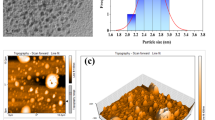Abstract
An imidazolate-bridged copper(II)-zinc(II) complex (Cu(II)-diethylenetriamino-μ-imidazolato-Zn(II)-tris(2-aminoethyl)amine perchlorate (denoted as “Cu,Zn complex”) and a simple copper(II) complex (Cu(II)-tris(2-aminoethyl) amine chloride (“Cu-tren”) were prepared and immobilised on silica gel (by hydrogen or covalent bonds) and montmorillonite (by ion exchange). The immobilised substances were characterised by FT-IR spectroscopy and their thermal characteristics were also studied. The obtained materials were tested in two probe reactions: catalytic oxidation of 3,5-di-tert-butyl catechol (DTBC) (catecholase activity) and the decomposition of hydrogen peroxide (catalase activity). It was found that the catecholase activity of the Cu,Zn complex increased considerably upon immobilization on silica gel via hydrogen bonds and intercalation by ion exchange among the layers of montmorillonite. The imidazolate-bridged copper(II)-zinc(II) complex and its immobilised versions were inactive in hydrogen peroxide decomposition. The Cu(II)-tris(2-aminoethyl)amine chloride complex displayed good catalase activity; however, immobilisation could not improve it.
Similar content being viewed by others
References
B.M. Weckhuysen, A.A. Verberckmoes, I.P. Vannijvel, J.A. Pelgrims, P.L. Buskens, P.A. Jacobs and R.A. Schoonheydt: “Zeolite encaged Cu(Histidine) complexes as mimics of natural Cu enzymes”, Angew. Chem. Int. Ed. Engl., Vol. 34, (1995), pp. 2652–2654.
M.R. Maurya, S.J.J. Titinchi, S. Chand and I.M. Mishra: “Zeolite-encapsulated Cr(III), Fe(III), Ni(II), Zn(II) and Bi(III) salpn complexes as catalysts for the decomposition of H2O2 and oxidation of phenol”, J. Mol. Catal. A Chem., Vol. 180, (2002), pp. 201–209.
S. Deshpande, D. Srinivas and P. Ratnasamy: “EPR and catalytic investigation of Cu(salen) complexes encapsulated in zeolites”, J. Catal., Vol. 188, (1999), pp. 261–269.
B.M. Weckhuysen, A.A. Verberckmoes, L. Fu and R.A. Schoonheydt: “Zeoliteencapsulated copper(II) amino acid complexes: Synthesis, spectroscopy and catalysis”, J. Phys. Chem., Vol. 100, (1996), pp. 9456–9461.
I. Szilágyi, G. Nagy, K. Hernadi, I. Labádi and I. Pálinkó: “Modelling coppercontaining enzyme mimics”, J. Mol. Struct. Theochem, Vol. 666, (2003), pp. 451–453.
V.V. Barynin, M.M. Whittaker, S.V. Antonyuk, V.S. Lamzin, P.M. Harrison, P.J. Artymiuk and J.W. Whittaker: “Crystal structure of manganese catalase from Lactobacillus plantarum”, Structure, Vol. 9, (2001), pp. 725–738.
A.J. Wu, J.E. Penner-Hahn and V.L. Pecoraro: “Structural, spectroscopic, and reactivity models for the manganese catalases”, Chem. Rev., Vol. 104, (2004), pp. 903–938.
J. Gao and S.H. Zhong: “Dimanganase(II)-catalase-like model complexes: synthesis, structure characterization and catalytic mechanism”, J. Mol. Catal. A Chem., Vol. 186, (2002), pp. 25–32.
Y. Sasaki, T. Akamatsu, K. Tsuchiya, S. Ohba, M. Sakamoto and Y. Nishida: “Solvent and structural effects on catalase-like function of binuclear manganese(II) compounds with μ-phenoxide bridge”, Polyhedron, Vol. 14, (1998), pp. 235–242.
E. Horozova and N. Dimcheva: “Study of catalase immobilized on a silicate matrix for non-aqueous biocatalysis”, Cent. Eur. J. Chem., Vol. 3, (2005), pp. 279–287.
J. Gao, A.E. Martell and R.J. Motekaitis: “Novel macrocyclic heterodinuclear catalase-like model complex CuMnL and CuZnL (L=BDBPH): synthesis, stability and catalytic properties”, Inorg. Chim. Acta, Vol. 325, (2001), pp. 164–170.
J. Gao, J. Reibenspies, A.E. Martell, S. Yizhen and D. Chen: “The first macrocyclic layer-to-layer type tetranuclear copper(II) complex: structure, stability and unprecedented catalase-like activity”, Inorg. Chem. Commun., Vol. 5, (2002), pp. 1095–1098.
J. Gao, A.E. Martell and J.H. Reibenspies: “Novel dicopper(II) catalase-like model complexes: synthesis, crystal structure, properties and kinetic studies”, Inorg. Chim. Acta, Vol. 346, (2003), pp. 32–42.
C. Belle and J.-L. Pierre: “Asymmetry in bridged binuclear metalloenzymes: lessons for the chemist”, Eur. J. Inorg. Chem., (2003), pp. 4137-4146.
D.A. Rockcliffe and A.E. Martell: “Stoichiometric and catalytic oxidations by dinuclear copper(I) and copper(II) complexes of a Schiff base ligand derived from the 2:2 condensation of pyridine 2,6-dicarboxaldehyde and 1,5,9-triazanonane”, J. Mol. Catal. A Chem., Vol. 106, (1996), pp. 211–221.
F. Zippel, F. Ahlers, R. Werner, W. Haase, H.-F. Nolting and B. Krebs: “Structural and functional models for the dinuclear active site in catechol oxidases: synthesis, X-ray crystal structures, magnetic and spectral properties, and X-ray absorption spectroscopic studies in solid state and in solution”, Inorg. Chem., Vol. 35, (1996), pp. 3409–3419.
J. Reim and B. Krebs: “Synthesis, structure and catecholase activity study of dinuclear copper(II) complexes”, J. Chem. Soc. Dalton Trans., (1997), pp. 3793-3804.
E. Monzani, G. Battaini, A. Perotti, L. Casella, M. Gullotti, L. Santagostini, G. Nardin, L. Randaccio, S. Geremia, P. Zanello and G. Opromolla: “Mechanistic, structural, and spectroscopic studies on the catecholase activity of a dinuclear copper complex by dioxygen”, Inorg. Chem., Vol. 38, (1999), pp. 5359–938.
R. Wegner, M. Gottschaldt, H. Görls, E.-G. Jager and D. Klemm: “Copper(II) complexes of aminocarbohydrate ß-ketoenaminic ligands: efficient catalysts in catechol oxidation”, Chem. Eur. J., Vol. 7, (2001), pp. 2143–2157.
J. Kaizer, J. Papp, G. Speier, L. Párkányi, L. Korecz and A. Rockenbauer: “Synthesis, structure and catecholase activity of dinuclear copper and zinc complexes with an N3-ligand”, J. Inorg. Biochem., Vol. 91, (2002), pp. 190–198.
M.C. Mimmi, M. Gullotti, L. Santagostini, A. Saladino, L. Casella, E. Monzani and R. Pagliarin: “Stereoselective catalytic oxidations of biomimetic copper complexes with a chiral trinucleating ligand derived from 1,1-binaphthalene”, J. Mol. Catal. A Chem., Vol. 204-205, (2003), pp. 381–389.
A. Naidja, P.M. Huang and J.-M. Bollag: “Activity of tyrosinase immobilized on hydroxyaluminium-montmorillonite complexes”, J. Mol. Catal. A Chem., Vol. 115, (1997), pp. 305–316.
M. Louloudi, K. Mitopoulou, E. Evaggelou, Y. Deligiannakis and N. Hadjiliadis: “Homogeneous and hydrogenised copper(II) complexes as catechol oxidation catalysts”, J. Mol. Catal. A Chem., Vol. 198, (2003), pp. 231–240.
I. Szilágyi, I. Labádi, K. Hernadi, I. Pálinkó, N.V. Nagy, L. Korecz, A. Rockenbauer, Z. Kele and T. Kiss: “Speciation study of an imidazolate-bridged copper(II)-zinc(II) complex in aqueous solution”, J. Inorg. Biochem., Vol. 99, (2005), pp. 1619–1629.
I. Szilágyi, I. Labádi, K. Hernadi, I. Pálinkó, I. Fekete, L. Korecz, A. Rockenbauer and T. Kiss: “Superoxide dismutase activity of a Cu-Zn complex-bare and immobilised”, New J. Chem., Vol. 29, (2005), pp. 740–745.
M. Sato, S. Nagae, M. Uehara and J. Nakaya: “Properties of imidazolate bridged copper(II)-zinc(II) complexes”, J. Chem. Soc. Chem. Commun., (1984), pp. 1661-1663.
J.L. Fernandez, C. Hurth and A.J. Bard: “Scanning electrochemical microscopy #54. Application to the study of heterogeneous catalytic reactions-hydrogen peroxide decomposition”, J. Phys. Chem. B, Vol. 109, (2005), pp. 9532–9539.
I. Labádi, I. Szilágyi, N.I. Jakab, K. Hernadi and I. Pálinkó: “Metal complexes immobilised in/on porous matrices-possible enzyme mimics”, Mater. Sci., Vol. 21, (2003), pp. 235–244.
I. Szilágyi, I. Labádi, K. Hernadi, I. Pálinkó and T. Kiss: “Synthesis and IR spectroscopic characterisation of immobilised superoxide dismutase (SOD) mimicking complexes”, J. Mol. Struct., Vol. 744-747, (2005), pp. 495–500.
G. Anderegg, N.G. Podder, P. Blauenstein, M. Hangartner and H. Stunzi: “Pyridine derivatives as complexing agents 10”, J. Coord. Chem., Vol. 4, (1975), pp. 267–275.
G. Anderegg and V. Gramlich: “1/1 metal-complexes of bivalent cobalt, nickel, copper, zinc, and cadmium with the tripodal ligand tris[2-(dimethylamino)ethyl]amine-their stabilities and the X-ray crystal-structure of its copper(II) complex sulfate”, Helv. Chim. Acta, Vol. 77, (1994), pp. 685–690.
R.R. Jacobson, Z. Tyeklar, A. Farooq, K.D. Karlin, S. Liu and J. Zubieta: “A Cu2-O2 complex-crystal-structure and characterization of a reversible dioxygen binding system”, J. Am. Chem. Soc., Vol. 110, (1988), pp. 3690–3692.
V. Raab, J. Kipke, O. Burghaus and J. Sundermeyer: “Copper complexes of novel superbasic peralkylguanidine derivatives of tris(2-aminoethyl)amine as constraint geometry ligands”, Inorg. Chem., Vol. 40, (2001), pp. 6964–6971.
N. Singh, K.K. Shukla, R.N. Patel, U.K. Chauhan and R. Shirastava: “E.s.r., magnetic, optical and biological (SOD and antimicrobial) studies of imidazolate bridged Cu(II)-Zn(II) and Cu(II)-Ni(II) complexes with tris(2-amino ethyl)amine as capping ligand: a plausible model for superoxide dismutase”, Spect. Acta A Mol. Spectrosc., Vol. 59, (2003), pp. 3111–3122.
M.A. Derosch and W.C. Trogler: “Hydrolysis of phosphodiesters with Ni(II), Cu(II), Zn(II), Pd(II), and Pt(II) complexes”, Inorg. Chem., Vol. 29, (1990), pp. 2409–2416.
Author information
Authors and Affiliations
About this article
Cite this article
Szilágyi, I., Horváth, L., Labádi, I. et al. Mimicking catalase and catecholase enzymes by copper(II)-containing complexes. cent.eur.j.chem. 4, 118–134 (2006). https://doi.org/10.1007/s11532-005-0009-6
Received:
Accepted:
Issue Date:
DOI: https://doi.org/10.1007/s11532-005-0009-6




